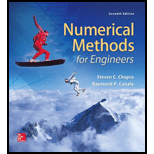
Ohm's law states that the voltage drop V across an ideal resistor is linearly proportional to the current i flowing through the resistor as in
TABLE P20.41
Experimental data for voltage drop across a resistor subjected to various levels of current.
| i | –2 | –1 | –0.5 | 0.5 | 1 | 2 |
| V | –637 | –96.5 | –20.5 | 20.5 | 96.5 | 637 |
To calculate: The value of V at
| i | 0.5 | 1 | 2 | |||
| V | 20.5 | 96.5 | 637 |
Answer to Problem 41P
Solution:
The value of V at
Explanation of Solution
Given Information:
The provided data is,
| i | 0.5 | 1 | 2 | |||
| V | 20.5 | 96.5 | 637 |
Formula used:
The zero-order Newton’s interpolation formula:
The first-order Newton’s interpolation formula:
The second- order Newton’s interpolating polynomial is given by,
The n th-order Newton’s interpolating polynomial is given by,
Where,
The first finite divided difference is,
And, the n th finite divided difference is,
Calculation:
Assume
First, order the provided value as close to 0.10 as below,
Therefore,
And,
The first divided difference is,
Thus, the first degree polynomial value can be calculated as,
Put
Solve for other values as,
And,
Similarly,
The second divided difference is,
Thus, the second degree polynomial value can be calculated as,
Put
And,
And,
The third divided difference is,
Thus, the third degree polynomial value can be calculated as,
Put
And, the error is calculated as,
Similarly the other dividend can be calculated as shown above,
Therefore, the difference table can be summarized as,
| Order | Error | |
| 0 | 20.5 | |
| 1 | 4.1 | |
| 2 | 15.984 | |
| 3 | 2.324 | 0 |
| 4 | 2.324 | 0 |
| 5 | 2.324 |
Since the error after order becomes zero, therefore, it can be concluded that the data is generated with a cubic polynomial.
Hence, the value of V at
Want to see more full solutions like this?
Chapter 20 Solutions
Numerical Methods for Engineers
- Algebra & Trigonometry with Analytic GeometryAlgebraISBN:9781133382119Author:SwokowskiPublisher:Cengage
